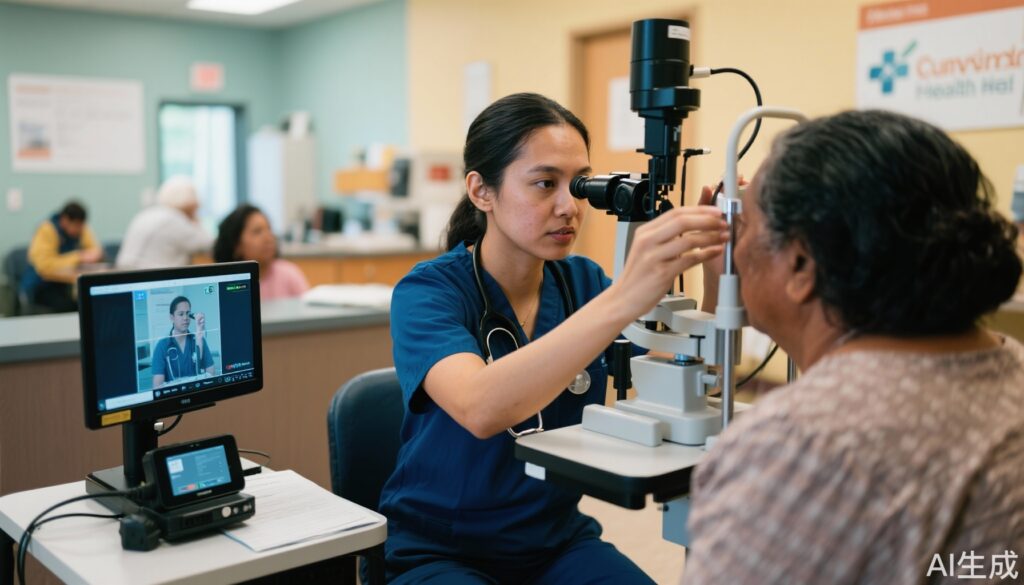Highlight
– The MI-SIGHT program implemented telemedicine-based glaucoma and eye health screening in community health centers, targeting underserved adult populations.
– Significant improvements were observed in visual acuity and vision-related quality of life after one year.
– Patient satisfaction was exceptionally high, with 99% reporting satisfaction or very satisfaction.
– Follow-up attendance reached 68%, although additional personalized education and coaching did not significantly enhance glaucoma-related follow-up beyond care navigation.
– The program was cost-effective, with an average cost of $110.99 per participant and $206.72 per diagnosed eye disease case.
Study Background and Disease Burden
Glaucoma is a leading cause of irreversible blindness worldwide, disproportionately affecting medically underserved populations due to barriers in screening and access to specialized ophthalmic care. Early detection and treatment are critical to prevent vision loss, yet many individuals in community health centers—serving low-income and high-risk groups—lack access to comprehensive eye exams. Additionally, uncorrected refractive errors contribute substantially to visual impairment and decreased quality of life but often remain untreated in these settings. To address these gaps, Michigan implemented the MI-SIGHT (Michigan Screening and Intervention for Glaucoma and Eye Health through Telemedicine) program, integrating telemedicine-enabled screening and intervention to improve eye health outcomes among adults receiving primary care at community health centers.
Study Design
This prospective cohort study with an embedded randomized controlled trial enrolled adults aged 18 years and older attending community health centers in Michigan. Participants underwent standardized eye disease screening by trained ophthalmic technicians utilizing telemedicine tools. Screening included measurement of visual acuity, assessment for glaucoma and diabetic retinopathy, and refractive error evaluation. Participants with detected eye disease were assisted in ordering affordable corrective lenses. A subset underwent repeat screening after one year to evaluate changes in visual acuity (VA) and vision-related quality of life (VRQOL), measured with the NEI-VFQ 9-item questionnaire.
For participants who screened positive for glaucoma or suspected glaucoma, a randomized controlled trial compared two interventions to enhance follow-up attendance: (1) care navigation with personalized education and health coaching (treatment arm) versus (2) care navigation with written education alone (control arm). Primary outcomes included eye disease prevalence, change in VA and VRQOL, patient satisfaction, attendance at recommended follow-up visits, and program costs. Statistical analyses employed z-tests for prevalence comparisons, paired t-tests and Wilcoxon signed-rank tests for VA and VRQOL changes, and chi-square tests for follow-up rate comparisons.
Key Findings
A total of 3,714 participants were analyzed, with notable disease prevalence exceeding national averages: 11.5% with visual impairment, 9.3% with uncorrected or undercorrected refractive error causing visual impairment, 22.4% diagnosed or suspected of glaucoma, and 4.7% with diabetic retinopathy (all P < 0.0001 compared to national rates). These results reflect the high burden of eye diseases in medically underserved populations.
Satisfaction with the MI-SIGHT program was outstanding, with 99% of participants reporting they were satisfied or very satisfied with their experience.
Repeat screening data from 943 participants demonstrated statistically significant improvement in worse-eye presenting VA, improving from an average logMAR of 0.25 ± 0.59 to 0.21 ± 0.52 (P = 0.0012). Additionally, VRQOL as measured by the NEI-VFQ 9-item composite score improved markedly from 81.1 ± 14.1 to 86.4 ± 12.0 (P < 0.0001), indicating meaningful enhancements in daily visual function and quality of life after program engagement.
Among 490 glaucoma-positive or suspected glaucoma participants randomized to either treatment or control, follow-up attendance was 61% in the treatment group and 59% in controls, with no statistically significant difference (P = 0.74) despite added personalized education and health coaching. However, the overall follow-up attendance rate of 68% across the program represents an important improvement over typical adherence rates in this population.
Cost analysis revealed that the program operated at an average cost of $110.99 per participant served and $206.72 per case of eye disease detected. This cost-effective model demonstrated feasibility for scale-up in community clinics, offering a sustainable telemedicine-based approach for glaucoma and eye health screening.
Expert Commentary
The MI-SIGHT program exemplifies an innovative telemedicine-driven framework to address health disparities in ophthalmology. By leveraging trained ophthalmic technicians in primary care settings, screening accessibility significantly expands. The improvement in both visual acuity and vision-related quality of life after intervention underscores the clinical relevance of correcting refractive errors and detecting eye disease early.
Although enhanced personalized education and coaching did not statistically increase follow-up attendance among glaucoma-suspected individuals beyond care navigation alone, the relatively high follow-up rates suggest that system-level supports are effective. Future investigations might explore combining digital reminders or community health worker outreach to further optimize adherence.
Cost-effectiveness data support the integration of telemedicine screening programs into resource-constrained settings. Limitations include the potential for selection bias and attrition in repeat screening, though the prospective cohort design with robust statistical measures strengthens confidence in study findings.
Conclusion
The MI-SIGHT program demonstrates that expanding glaucoma and eye disease screening with telemedicine and treatment of refractive errors in community health centers can enhance vision outcomes and patient-reported quality of life among medically underserved adults. High patient satisfaction and favorable cost metrics support scaling such interventions to reduce preventable vision loss. Streamlined care navigation remains crucial, though additional targeted strategies to improve follow-up adherence warrant further research.
References
Newman-Casey PA, Niziol LM, Elam AR, Bicket AK, Ramachandran R, Johnson L, Kershaw M, Winters S, Woodward MA. Michigan Screening and Intervention for Glaucoma and Eye Health through Telemedicine Program: Impact on Vision, Follow-up, and Costs. Ophthalmology. 2025 Sep;132(9):1033-1044. doi: 10.1016/j.ophtha.2025.04.027. Epub 2025 Apr 29. PMID: 40311700; PMCID: PMC12353381.


